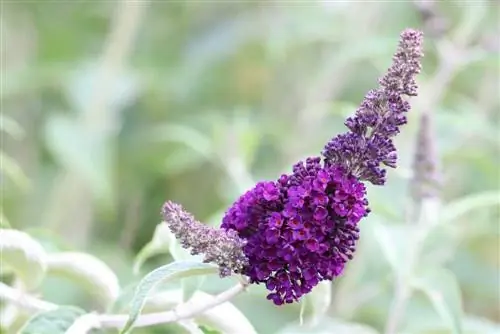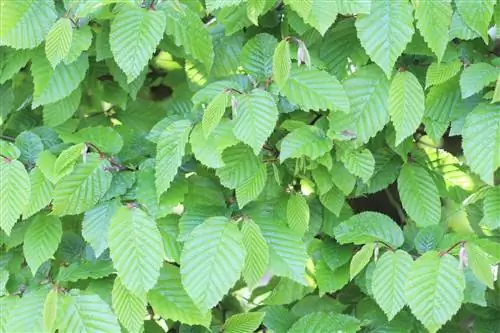- Author admin [email protected].
- Public 2023-12-17 03:39.
- Last modified 2025-01-24 12:45.
Hedges serve primarily as a privacy screen from the street and neighbors and are usually just green. But that doesn't have to be the case, because there are also flowering hedges. A planting plan is indispensable for a flower hedge that is created from different perennials. The plan lists important details about the hedge, such as size and position. Of course, the plants used should not be missing either. A planting plan, for example, offers the advantage that perennials can be positioned optimally and thus also offer better privacy. In addition, the space can be used optimally, which means that not only can the plants develop well, but you also don't have to spend a lot of money unnecessarily on a hedge.
What is a planting plan?
A planting plan consists of at least two elements: a sketch of the location with the future plants and a list of the plants. Before you start drawing the positions for plants on the sketch, the surrounding details of the future flowering plant hedge are drawn. These include, for example, boundaries such as walls or gates or other objects that are directly at or near the hedge. This has the advantage that hedge plants are not planted too close to house walls and could cause damage to the masonry. Once the environment has been sketched, the plants are marked where they should later stand, taking into account certain factors such as the estimated maximum size or underplanting of ground cover plants. Each circle drawn on a hedge plant is given a number and entered into a list below.
The list of plants can be supplemented with further details, such as flowering times, which means that a flowering hedge can be planted almost all year round by mixing different types of perennials. It can also be noted whether the perennials are growing very quickly or slowly. This makes it easier to create a plan for regular hedge trimming later.
Tip:
If the planting plan is created with a drawing program on the PC, the individual positions and size ratios can be changed more easily.
Select varieties
Especially with mixed hedges made of flowering plants, choosing varieties is very difficult, but with the right choice, each perennial will gradually bloom, meaning there will always be flowers in different parts of the hedge. Forsythia is one of the first flowering perennials of the year that are suitable for a hedge. Their golden yellow flowers are a welcome treat for the first bees of the year. Lilacs, which bloom in mid-spring until almost early summer, are also indispensable. There are different colors of lilac such as white, pink and different shades of purple. If there is enough space, several colors can be planted in different sections of the hedge, creating a colorful picture. Many of the flowering shrubs often only bloom until June or July and then often only show their green foliage. If you want to add late bloomers to your hedge, you should look for deliberately bred varieties of rhododendrons, for example, that only bloom from July or August. In terms of colors, the marshmallow is the lilac of summer. Its large flowers only bloom in summer and offer a similar range of colors to lilac up to various shades of blue. The number of flowering shrubs in winter is very small, one of the most popular is witch hazel, certain species of which bloom from autumn onwards. The various shrubs can be used to create a hedge that presents itself in the most colorful colors almost all year round and at the same time provides good privacy protection.
Planning natural hedges
In addition to ornamental shrubs, a flowering hedge can also be planted with wild shrubs, which are also a habitat for many animal species. However, the space requirement should generally be calculated more generously, as natural hedges are cut less often, which is why sufficient space to the neighbor or the street should be taken into account. One of the wild shrubs that can be used for hedges is the cornelian cherry. Larger perennials in particular score points with their yellow flower clusters, which bloom in early spring. Elderberry is an indispensable shrub for natural hedges. If cut regularly, it will not develop into a tree but will remain bushy. The blackthorn not only provides privacy protection, but also exudes an intoxicating scent. It blooms before the elderberry or almost at the same time as the elderberry and looks like a white snow globe because it is covered all over with delicate little flowers. The hawthorn is also one of the wild shrubs that are suitable for a magnificent flower hedge. It blooms from around May and is a popular pasture for bees.
Tip:
Natural hedges should only be cut rarely or only when necessary. However, they have the advantage that they require less care, as many shrubs grow more slowly.
Calculate space
The different shrubs for a flowering hedge also require different space requirements, which is due on the one hand to their growth rate and on the other hand to their growth habit. The rhododendron, for example, has a more wide growth habit, whereas the marshmallow has a narrower growth habit. The perennials and their space requirements are entered into the plant plan for flowering hedges, so that no perennials get in the way. In addition, the location requirements should also be taken into account in the plant plan and perennials with a high nutrient requirement should be positioned next to plants with lower nutrient requirements. This also makes it easier to fertilize the perennials later.
Make regular topiary cuts
Hedges made of ornamental shrubs should be trimmed regularly. This has the advantage that they require less space and can be planted more densely and also grow more evenly. These aspects can already be included in the plant plan, which always creates enough space for the next shrub, which is its turn to produce flowers.
The messengers of spring as hedge plants
Forsythia is widespread, with some varieties blooming bright yellow as early as March, ushering in spring. It is also called golden lilac or golden bell because of its color. The flowers first appear in spring, then the oval leaves form, which turn yellowish-green in autumn and, in some varieties, wine-red, bringing color to the garden even late in the year. The forsythia grows up to four meters high and should be cut back immediately after flowering in order to get lots of flowers again next year. It is best placed in a somewhat sheltered position because the flowers cannot tolerate frost.
The Kolkwitzia also grows up to four meters high. It blooms in May with abundant pink and white flowers. It is very undemanding, but needs a sunny or at least bright location. Older branches should be pruned regularly, which can be done all year round. From August to September, hairy fruits form on the Kolkwitzia, of which the dried calyxes remain.
Shrubs for flowering in summer
Lilac blooms from May to June in a delicate light purple, dark purple or white and smells very good. The buddleia blooms a little later between July and October and is available with white, pink or purple flowers. The hibiscus also blooms late. Due to its origins, it needs a sunny, wind-protected place where it blooms until autumn. It should be cut in spring before it develops leaves so that it becomes nice and bushy.
Hydrangeas can also be used very well for a hedge. There are about 80 species that bloom in different colors and reach different heights. Some of them shed their leaves in autumn, but some varieties are also evergreen. For most species the flowering period lasts from June to August.
The hedge can also bloom in winter
For flowering in winter, there is the Viburnum Bodnantense Dawn in the genus Snowball, which produces many small pink-white flowers from November to March and thus provides a little color in the dark season. Only after flowering does it produce leaves that turn yellow and red in autumn. It only needs to be thinned out after flowering if necessary.
The blooming hedge throughout the year
In order to add a little color to the garden through the hedge at any time of the year, different shrubs can be selected and planted next to each other. Then one after the other the bushes are in full bloom, creating a varied look. Depending on your taste, similar or completely different colors can be combined with each other.
Frequently asked questions
How long does it take for a flowering hedge to become opaque?
As a rule, it takes longer until flowering hedges are so dense that no one can see through them anymore, as they put their energy primarily into flowering or fear. However, flowering hedges are visually more appealing than purely evergreen hedges made from Thujen, for example.
Do flowering hedges need to be watered regularly?
In principle, flowering shrubs for hedges do not require any additional watering. Only in very dry summers, like any other hedge, should it be watered regularly - if this is not the case, flowering shrubs often last longer than thujas, as they have more opportunities to reduce their water requirements, for example by shedding leaves.






